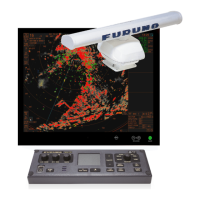3. TARGET TRACKING (TT)
3-21
The true course and speed of own ship are computed from own ship's gyro and speed
inputs, and the resulting course and speed of each tracked target is easily computed
by vector summing of the relative motion with own ship’s course and speed. The re-
sulting true or relative vector is displayed for each of the tracked targets. This process
is updated continually for each target on every scan of the radar.
Qualitative description of tracking error
The FURUNO TT's accuracy complies with or exceed IMO standards.
Own ship maneuvers
For slow turns there is no effect. For very high turning rates (greater than 150°/minute,
depending on gyro), there is some influence on all tracked targets that lasts for a min-
ute or two then all tracked targets revert to full accuracy.
Other ship maneuvers
Target ship courses, lag 15 to 30 seconds at high relative speed, or 3 to 6 seconds at
low (near 0) relative speed. It is less accurate during a turn due to lag, but accuracy
recovers quickly.
3.19 Factors Affecting TT Functions
Low gain
Insufficient or low radar receiver gain will result in some targets not being acquired at
long distance. TT display will be missing on one or more targets that could only be vis-
ible if the radar sensitivity control (GAIN control) were increased.
The setting of the correct radar receiver gain is not critical but the target should be on
the radar PPI and be clearly visible and well defined.
Manual acquisition is done if a target is positively displayed more than once. Automat-
ic acquisition is done when the target is detected 5-7 times continuously. Tracking is
achieved when the target is detected five times (not necessarily continuously) out of
10 scans. If not detected six times out of 10 scans, the target will become a “lost tar-
get”. The TT will acquire a radar echo that is present once in every six antenna scans
and continue tracking if 1 in 10.
Sea returns
If the radar anti-clutter control is adjusted properly, there is no serious effect because
distant wave clutter, not eliminated by this control, is filtered out by more than one
bang correlation and scan-to-scan matching of data.
Rain and snow
Clutter can be acquired and tracked as targets. Adjust the A/C RAIN control. If it is
heavy rain, switch to S-band if provided, or switch on the interference rejector on the
radar. If heavy clutter still exists, switch to manual acquisition. Accuracy can be affect-
ed.
Low clouds
Usually no affect. If necessary, adjust the A/C RAIN.

